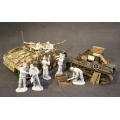German Armour Prototypes (7 JULY)
 |
GERMAN ARMOUR Although it was quickly surpassed by more powerful successors, the Panzer I’s contribution to the early victories of Nazi Germany during WW 2 was significant.
MUNITIONSSCHLEPPER auf PANZERKAMPFWAGEN Ausf.1 A (Sd.Kfz 111)
PANZER I AUSF.A – AMBULANCE VERSION
As the war progressed new types of more modern and efficient combat vehicles were developed and built. The Panzer I’s quickly became obsolete and were relegated to secondary roles, both at the front and the rearguard.
|



